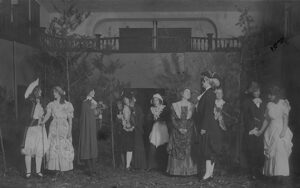
Beginning in 1893, the State Normal and Industrial School created two Literary Societies, the Adelphian and Cornelian literary societies. All students were inducted into one Society or the other, determined randomly. These groups hosted many of the events on campus, including plays, debates, socials, and dances, as entertainment for the student body.
The idea to create the Societies came after a group of students were caught creating their own private sorority. President Charles McIver had outlawed such groups on campus, feeling that they created an environment where certain students would be excluded. However, he could see that many on campus wanted a sorority-like organization, so he charged two students to create these sorority-like groups that included everyone.
The Adelphian Literary Society was one of two original societies founded in 1893. Dr. Charles McIver picked Mary Arrington to lead in the organization of the “A” society. She eventually became its first president. It was decided that the colors of the Society would be red and gold and their emblem to be a “greased pole.” Their motto was “Society of Sisters.”
The Cornelian Literary Society was also established in 1893. Founded and organized by Alice Green, it was originally known as “G” before being renamed the Cornelian Society. This name honored Cornelia, the mother of the Gracchi Twins of Roman legend. Their colors were blue and gold, and they had a goat as their mascot. Their motto was “For fellowship, knowledge, and culture.”
For a while these two Societies functioned as both secret societies and social clubs. At the very beginning, they served, as the name suggests, a place to discuss literature. They also, however, put on plays and hosted debates. These groups offered intellectual and social activities outside of class.
In 1918, the school had grown to such a size that a third group was added, the Dikeans. By 1923, a fourth was added, the Alethians.

The Dikean Literary Society, founded in 1918, was originally comprised of members of each of the other two Societies, and then began to induct its own members by 1919. Its name is Greek, meaning justice, equality, and rectitude. Its colors were green and gold.
The Alethian Society was founded in 1922, in response the growth of the college and effort to keep the Societies small enough that students would feel welcome in them. They drew their newest members from the three existing Societies. They adopted Alethian–also Greek, meaning “Truth”–as their name, and their colors were violet and gold.
The Societies underwent one more change in 1930, dividing each of the Societies into an Alpha and Beta chapter, once again hoping to keep things on a smaller scale so more people could feel like they could participate.
As time went on, however, the groups began to be more like social clubs than secret societies. They were responsible for hosting dances and the election of Marshals. They began see themselves as a way to help the younger girls become integrated and comfortable with campus life. These groups emphasized equality among its members as well as development of leadership skills.
Starting in the 1930s, however, they began to decline, with many of their original functions being displaced by other groups. In 1953 the Societies were formally disbanded with the approval of the presidents.
By Kristen Thomas, History Department intern, Spring 2013; Edited by Cecil Barlow, 2025